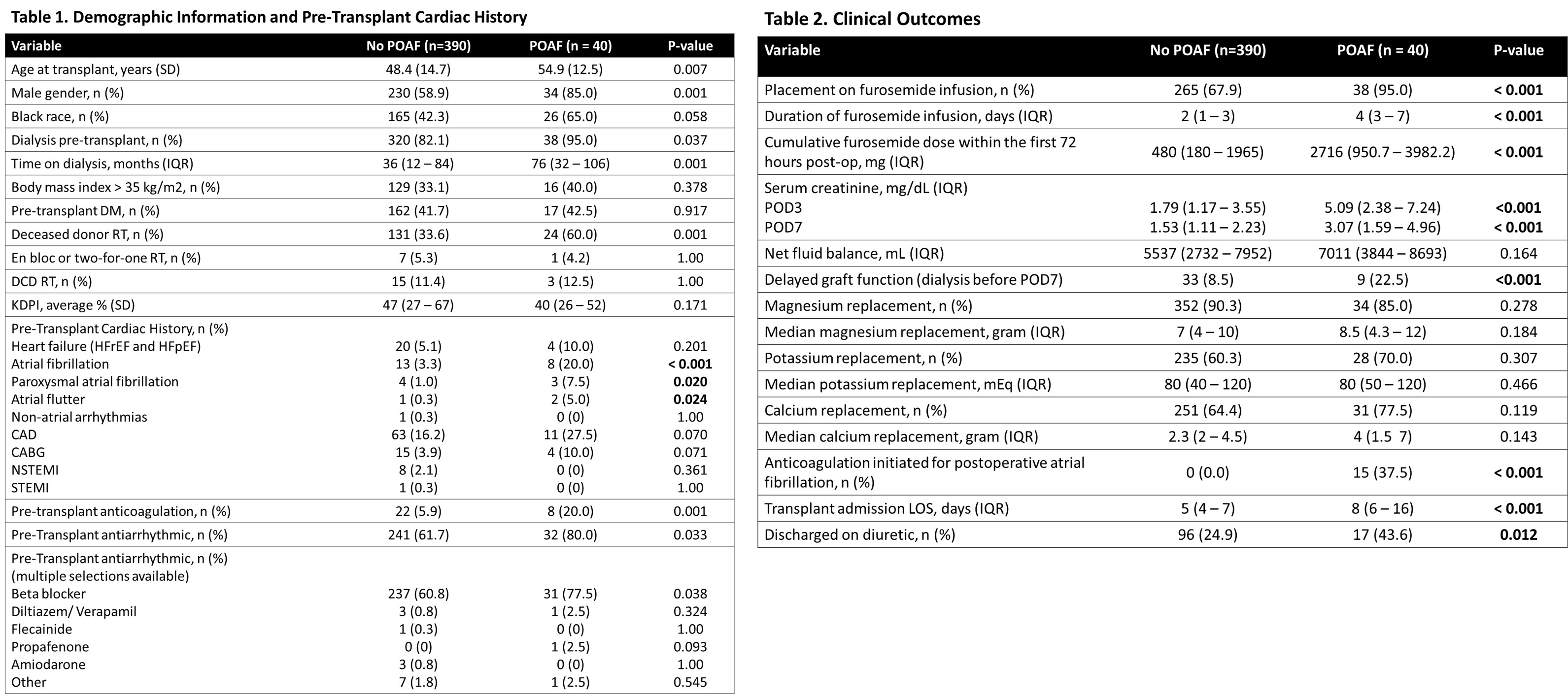Predictors of Postoperative Atrial Fibrillation in an Urban, Obese Adult Renal Transplant Population
A. Lichvar, Z. Ress, M. Tabriz, H. Jenkins, T. Walsh, I. Tzvetanov, E. Benedetti, M. Campara
University of Illinois at Chicago, Chicago, IL
Meeting: 2021 American Transplant Congress
Abstract number: 901
Keywords: Adverse effects, Kidney transplantation, Obesity
Topic: Clinical Science » Kidney » Kidney: Cardiovascular and Metabolic Complications
Session Information
Session Name: Kidney: Cardiovascular and Metabolic Complications
Session Type: Poster Abstract
Session Date & Time: None. Available on demand.
Location: Virtual
*Purpose: Postoperative atrial fibrillation (POAF) is a common surgical complication. Renal transplant (RT) recipients possess risk factors that may lead to a higher incidence of POAF. Past evaluations did not include obese RT recipients. The purpose of this analysis is to identify factors associated with the development of POAF after RT in a diverse population.
*Methods: Adult RT recipients between 1/1/2013 – 12/31/2017 at the University of Illinois Hospital were analyzed. POAF was identified by electrocardiogram. Furosemide dosing and net fluid balance were collected within the first 3 postoperative days (POD). Delayed graft function was defined as requiring dialysis within the first 7 days post-RT. The primary outcome was to describe the incidence of POAF. Demographics, pre-transplant cardiac history, and clinical course were compared between those with and without POAF. Univariate and multivariate logistic regression models were built to identify risk factors for POAF. Area under the receiver operating characteristic curve (ROC AUC) was reported in the final model.
*Results: A total of 430 RT recipients were included in the analysis. The incidence of POAF was 9.3%. Demographics and cardiac history are detailed in Table 1. Those with POAF received more furosemide (p<0.001) without difference in net fluid balance (p=0.164), experienced more DGF (p<0.001), and had longer transplant admission LOS (<0.001). Clinical course outcomes are demonstrated in Table 2. Increasing age (OR 1.53, p=0.03), increasing body mass index (BMI) (OR 2.69, p<0.001), history of prior pre-RT atrial arrhythmias (OR 7.09, p=0.002), increasing IV calcium supplementation requirements (OR 1.12, p=0.005), and increasing cumulative furosemide dosing (OR 1.37, p=0.012) were associated with increased risk of POAF (Table 3). ROC AUC was 86.4% (Figure 1).
*Conclusions: Judicious fluid management is required in RT recipients who are older in age, obese, and have a pre-RT history of atrial arrhythmias. Appropriate replacement of calcium and utilization of furosemide in tandem with fluid management should also be pursued. Protocols guiding fluid management in a high POAF risk population should be developed and evaluated.
To cite this abstract in AMA style:
Lichvar A, Ress Z, Tabriz M, Jenkins H, Walsh T, Tzvetanov I, Benedetti E, Campara M. Predictors of Postoperative Atrial Fibrillation in an Urban, Obese Adult Renal Transplant Population [abstract]. Am J Transplant. 2021; 21 (suppl 3). https://atcmeetingabstracts.com/abstract/predictors-of-postoperative-atrial-fibrillation-in-an-urban-obese-adult-renal-transplant-population/. Accessed December 14, 2025.« Back to 2021 American Transplant Congress


